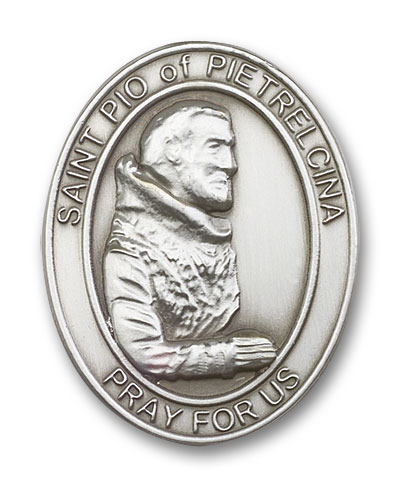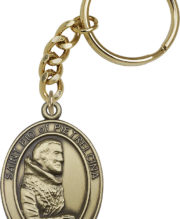Saints
St. Padre Pio – St. Pio of Pietrelcina
St. Pio of Pietrelcina St. Padre Pio Biography
St. Pio of Pietrelcina, also known as Padre Pio, was a Catholic priest, mystic, and stigmatist who lived in the early 20th century. He was born on May 25, 1887, in Pietrelcina, Italy, and was baptized with the name Francesco Forgione.
Padre Pio was known for his deep devotion to God and his strong commitment to the Catholic Church. He entered the Capuchin religious order at a young age and was ordained a priest in 1910. Throughout his life, he was known for his spiritual guidance, his healing powers, and his ability to perform miracles.
One of the most notable characteristics of Padre Pio’s life was the stigmata, which were visible wounds on his hands, feet, and side that were said to resemble the wounds of Jesus Christ on the cross. These wounds were a source of much controversy and debate, but were ultimately accepted by the Catholic Church as authentic.
Padre Pio was also known for his ability to perform miracles. Many people came to him seeking help and healing, and he is said to have helped countless people through his prayers and his powers of intercession. He was also known for his ability to bilocate, or to be in two places at once, which was also a source of controversy and debate.
Despite his fame and popularity, Padre Pio lived a life of humility and simplicity. He devoted himself to prayer and to serving others, and he was known for his compassion and kindness. He was a great devotee of the Virgin Mary, and he had a special devotion to the Rosary.
Padre Pio was also a strong advocate of confession and penance. He would often spend hours each day hearing confessions, and he encouraged people to confess their sins and to make a good confession. He believed that confession and penance were essential for spiritual growth and for a deeper relationship with God.
Padre Pio passed away on September 23, 1968. After his death, many people reported miracles and healings attributed to his intercession, and in 1999 he was canonized as a saint by Pope John Paul II. Today, he is remembered as a powerful intercessor and a spiritual guide, and his tomb at the Sanctuary of Santa Maria delle Grazie in San Giovanni Rotondo, Italy, remains a pilgrimage site for many Catholics.
In conclusion, St. Pio of Pietrelcina was a beloved and revered Catholic saint known for his deep devotion to God, his strong commitment to the Church, and his miraculous powers. He lived a life of humility and simplicity, and his example continues to inspire and guide many Catholics today.
Popular St. Pio of Pietrelcina Medal and St. Pio of Pietrelcina Rosary
Why is St. Pio of Pietrelcina the patron saint of youth and the sick?
St. Pio of Pietrelcina, also known as Padre Pio, is the patron saint of several causes and groups, including:
-
The sick: Many people believe that Padre Pio had the ability to heal the sick through his prayers, and as a result he is often invoked as a patron saint for those who are ill.
-
Confessors: Padre Pio was a priest and confessor, and as a result, many people look to him as a patron saint for guidance in the sacrament of confession.
-
Civil defense volunteers: Because of his ability to perceive distant events and often warn people of upcoming disasters he is also considered a patron of Civil Defense volunteers
-
The youth: Padre Pio was known for his deep love and concern for the young, and as a result, many young people look to him as a patron saint and model of holiness.
-
Those bearing the wounds of Christ, also called stigmatics.
It is important to notice that these causes and groups are not the only ones associated with Padre Pio, and that devotion to him is often quite personal, with many people asking for his intercession for a variety of needs. The reasons for the patronage for these groups come from the events, actions and miracles that took place during his life and after his death, that were acknowledged by the church and are considered as examples of his holiness and closeness to God.
Miracles of St. Pio of Pietrelcina
St. Pio of Pietrelcina, also known as Padre Pio, was an Italian Catholic priest, friar, and mystic who lived in the early 20th century. He is known for many alleged miraculous abilities and experiences, such as the ability to bilocate, heal the sick, and read souls. He is said to have experienced the stigmata, or the wounds of Christ, and to have had the ability to perform other miraculous acts.
One of the most well-known miracles associated with Padre Pio is his ability to heal the sick. Many people reported being cured of various illnesses and diseases after visiting him or praying for his intercession.
Another miraculous ability attributed to Padre Pio is bilocation, the ability to be in two places at once. He was said to have been seen in different places at the same time, such as in the confessional and at the same time in another location.
Padre Pio was also known for his ability to read souls, and many people reported that he knew their innermost thoughts and feelings even before they confessed them. Some also believed that he had the ability to levitate, and that he was able to experience ecstasies, or mystical experiences of union with God.
It should be noted that many of the alleged miracles attributed to Padre Pio have not been confirmed by the Catholic Church. The Catholic Church has an office of inquiry, also called the Devil’s Advocate, that investigates these cases and determines whether they are worthy of canonization. However, the process of canonization can be long and arduous, so it’s not necessarily uncommon for some of the alleged miracles to be unverified or disputed.
Even with the unverified miracles, Padre Pio is highly revered and still celebrated by many Catholics around the world for his life of piety, devotion, and service, and for his powerful intercession in prayer.
Prayers to St. Pio of Pietrelcina
Prayer of Intercession to St. Pio of Pietrelcina
O dear St. Pio, you were a true friend of God and a faithful servant of His Church. I place myself under your powerful intercession and ask for your help in this time of need. Please pray for me, that I may be granted the grace and strength to overcome (mention your petition here) and that I may grow in the likeness of Jesus Christ. Help me to imitate your devotion to prayer, your humility, and your love for others, so that I too may become a true instrument of God’s love in the world.
Prayer to St. Pio of Pietrelcina for healing
O most loving and compassionate Padre Pio, you were known for your power to heal the sick through your prayers. I come to you today in need of your healing touch. Please intercede for me with our Lord, Jesus Christ, and ask that He grant me the physical and spiritual healing that I so desperately need. Help me to trust in God’s plan for my life, and give me the strength and courage to face any suffering that may come my way.
Quotes by St. Pio of Pietrelcina
-
“Pray, hope and don’t worry.” – This quote emphasizes the importance of prayer, hope, and trust in God.
-
“The real and essential love is the love for God, who is the supreme Good.” – This quote expresses the idea that the ultimate goal of human love should be love for God.
-
“God is not pleased with those who are half-hearted and tepid. He wants all or nothing.” – This quote encourages people to be completely dedicated to God, not just in a half-hearted way.
-
“Prayer is the best weapon we possess; it is the key that opens the heart of God.” – This quote emphasizes the power of prayer and its ability to open the heart of God.
-
“The more a soul loves, the more it suffers.” – This quote expresses the idea that true love involves suffering, and the more one loves, the more they will suffer.
-
“Prayer is not asking. It is a longing of the soul. It is daily admission of one’s weakness. It is better in prayer to have a heart without words than words without a heart.” – This quote emphasizes that prayer is not just asking for things, but it’s a longing of the soul, and it is important to have a heart without words than words without a heart.
-
“Love is the light which dispels all darkness.” – This quote expresses the idea that love is the source of light that dispels all darkness, including the darkness of evil.
-
“The crown of the man who truly loves is humility.” – This quote emphasizes that true love is associated with humility.
Children’s Story about the life of St. Pio of Pietrelcina
Once, in a small town called Pietrelcina in Italy, there was a little boy named Francesco. Francesco was a very special boy, he loved to go to church and spend time in prayer. He would often spend hours at a time praying in front of the statues of the saints, asking them to help him grow closer to God.
One day, when Francesco was only nine years old, he had a very special dream. In his dream, a kind and gentle man appeared to him and told him that his name was Padre Pio. The man told Francesco that God wanted him to become a priest and serve Him in a special way.
Francesco was so excited about this dream that he told his parents about it right away. They were very proud of their son and encouraged him to follow his dream. So, after many years of studying and praying, Francesco finally became a priest and took the name Padre Pio.
Padre Pio was a very special priest, he was known for his deep love and devotion to God, his humility and charity towards others and his ability to perform many miracles. He spent much of his time serving the poor and the sick and was loved by everyone who knew him.
One day, a very special thing happened to Padre Pio. He started to have a physical manifestation of the wounds of Jesus Christ on his hands, feet and side. This was a great mystery, but it only added to the devotion and admiration of the people towards him.
Padre Pio also received many visions of Jesus and Mary and he was able to perceive many things that were happening at a distance, he would often inform people about an event that was about to happen in another place.
Padre Pio’s devotion to God and his love for others made him one of the most beloved saints of all time. Even after his death, many people continue to seek his intercession and ask for his help.
The end
Please keep in mind that this is a fictionalized account of the life of St. Pio of Pietrelcina, the story is intended to be accessible for children and thus some details of his life have been simplified or left out. As an adult, it’s important to get accurate information about the life of saints to understand and appreciate their message.
Papal Writings and Sermons about St. Pio of Pietrelcina
St. Pio of Pietrelcina, also known as Padre Pio, was a popular and highly venerated Catholic priest and mystic, several Popes throughout history have written or spoken about him and his life.
Pope John Paul II, who canonized Padre Pio in 2002, gave several homilies and addresses that praised the life and holiness of Padre Pio. He highlighted Padre Pio’s devotion to prayer, his humility and charity towards others, his life of sacrifice, and his ability to perform miracles. Pope John Paul II also praised Padre Pio for his work as a confessor and spiritual guide, stating that his guidance had helped many people to grow in their faith.
Pope Benedict XVI, in a letter to the faithful, praised Padre Pio for his life of prayer and suffering, which was offered for the Church, for the Pope, for the spiritual and material needs of the brothers, for the conversion of sinners and for peace in the world. He also highlighted Padre Pio’s role as a spiritual guide, calling him “a true master of the spiritual life,”
Pope Francis during a meeting with the Capuchin monks, he spoke of Padre Pio, praising his humility and his ability to help others through his prayers. The Pope also praised Padre Pio’s commitment to the sick and the poor, calling him a “man of faith and of charity.”
It is worth mentioning that Popes are not the only authority in the Catholic Church, and there are many writings, sermons and homilies from bishops, priests, religious and lay people that praise the life and holiness of Padre Pio, his teachings and guidance still have an important impact in many catholic communities.
Reflection on the Feast of St. Pio of Pietrelcina
Today, the Catholic Church celebrates the feast of St. Pio of Pietrelcina on September 23rd
On the feast day of St. Pio of Pietrelcina, we are reminded of the powerful example of this beloved saint and the lessons we can learn from his life.
Padre Pio, as he was known, lived a life deeply devoted to God, his strong commitment to the Catholic Church, and his example of humility, compassion and spiritual guidance. He was known for his mystical experiences, his ability to perform miracles and his devotion to the Virgin Mary and the Rosary, which we can all look at as an inspiration.
One of the most notable characteristics of Padre Pio’s life was the stigmata, which were visible wounds on his hands, feet and side that were said to resemble the wounds of Jesus Christ on the cross. These wounds, which were not only a physical manifestation of his devotion but also a call for us all to carry our crosses, were a source of much controversy and debate, but were ultimately accepted by the Catholic Church as authentic. This is a reminder for us to embrace our own crosses, and to find meaning and purpose in the struggles and difficulties we face.
Padre Pio’s devotion to Confession and Penance can also serve as an inspiration for us. He would spend hours each day hearing confessions, and he encouraged people to confess their sins and to make a good confession. He believed that Confession and Penance were essential for spiritual growth and for a deeper relationship with God. Let’s reflect today on the importance of Confession, on the value of examining our conscience and asking for forgiveness, as it is through this sacrament that we receive the grace of reconciliation with God.
Padre Pio’s devotion to the Rosary was also remarkable, he taught that reciting the Rosary was a way to meditate on the life of Jesus and the Virgin Mary, and to find peace and guidance in times of trouble. On this feast day, let’s remember to make the Rosary a part of our daily lives, as it is a powerful tool for growing in our faith and in our devotion to Mary, the Mother of God.
Lessons learned from St. Pio of Pietrelcina
St. Pio of Pietrelcina, also known as Padre Pio, was a Catholic priest, mystic, and stigmatist who lived in the early 20th century. He is considered a spiritual figure by many Catholics, and is known for his devotion to prayer and his ability to perform miracles. Some lessons that can be learned from his life include:
-
The importance of devotion to prayer: Padre Pio’s life was deeply marked by his devotion to prayer and his belief in the power of God to heal and transform people’s lives.
-
The power of forgiveness and humility: Padre Pio was known for his humility and willingness to forgive others, even in the face of great suffering.
-
The importance of service to others: Padre Pio spent much of his life serving others, particularly the poor and the sick. He is remembered for his compassion and dedication to helping those in need.
-
The belief in miracles: Padre Pio’s life was marked by the many miraculous events that occurred around him, including healing of the incurable diseases, predictions, levitation and bilocation, many of these were investigated and certified by the church.
-
The importance of spiritual guidance: Padre Pio was a spiritual guide to many people during his life, and his guidance and counsel continue to be sought after today by many Catholics seeking spiritual direction.
Saints Similar to St. Pio of Pietrelcina
You may also be interested in reading the Biography of St. Francis of Assisi. St. Pio of Pietrelcina and St. Francis of Assisi were Italian saints known for their deep spirituality and their stigmata, marking them as individuals closely connected to the suffering of Christ. Next up: Biography of St. Pius X
Also check out our handmade St. Pio of Pietrelcina Medal and St. Pio of Pietrelcina Rosary and St. Pio of Pietrelcina Rosary Bracelet .




